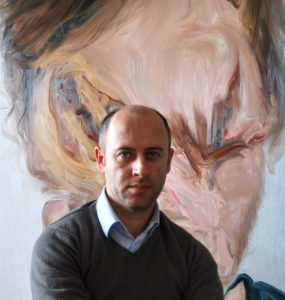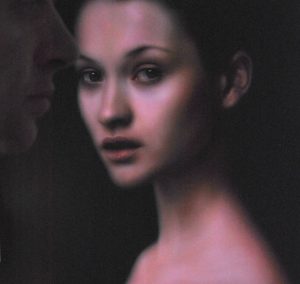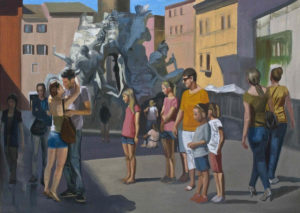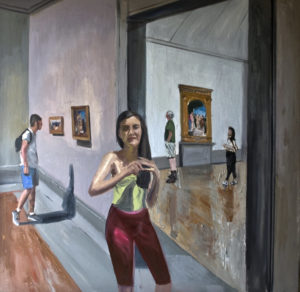Contemporary art operates with a clean cut, if not even despising, mocking the past, without thinking that art is nothing but a very long succession of models and archetypes that have settled over time, in harmony between innovation and tradition.
In this sense does not sin with pride Federico Lombardo, born in Castellamare di Stabia and resident in Rome, supporter of the importance of questioning established values. In his works live experimentalism and pastism, alienating portraits that want to express neutral feelings, inspired by Renaissance models and digital technology (unlike the more elusive ones made on canvas), Giotto’s compositional re-enactments and scenes of contemporary everyday life.
Graduated in sculpture at the Academy of Fine Arts in Naples, Lombardo, far from the historical tradition of the twentieth century, often incorporates elements of sculpture that form the background and characters that look like ghosts, depictions of dreams and memories.
The creative corpus of Lombardo is variegated; for him the search for new values of vision is fundamental, relying on the immediate impression of truth, and rejecting any canonical and ideological process of representation. His works are wrapped in an atmosphere reminiscent of the films of Jean Renoir, because art in the mind and hands of Lombardo becomes cinema on the canvas, dynamism, movement. Color is an effective expressive means to give back to each what its weight and its volume, a bit in the manner of Jean-Frédéric Bazille, capturing the everyday naturalness and eternity of a life in which art is always present.
Federico Lombardo’s works, which demonstrate his versatility, were shown at European Parliament in Strasbourg, in the Palladian Basilica in Vicenza, at the Pac in Milan, in biennials (Venice and Sharjah) and quadrennials. His last solo show, “Monade” dates back to 2018 in Milan, curated by Federico Rui. The next solo exhibition will be in Bassano at the Bank collection.
You have been included in the diary of Italian living painters “Excellent painters” by the journalist and art critic Camillo Langone, but who are excellent painters for you and which you consider to be the aspect of your art that makes you an excellent painter?
Camillo has known my artistic career for almost 15 years; he is like a Vasari of the 21st century, at least this is his intention; it is evident that he identifies in my painting technical qualities, stylistic such as to make me participate in his project. Why I am considered excellent, maybe I’m the least suitable person to answer, you should ask him. He often compares me to Impressionist or contemporary painters of the caliber of Erich Fischl, so he certainly identifies in my art an expressive capacity made of fast, intense, expressive brushstrokes.
The painter is excellent when this problem does not arise, but when he builds his work gradually through a poetic, a creed, which can last a lifetime.
I recently visited The Mirò Foundation and the Picasso Museum in Barcelona, they are obviously more than excellent mythical artists. Following their example is the minimum. I don’t like revised concepts re-proposed as absolute originality.
How much need is there today for a humanistic art?
Art is always humanistic, because it is designed and made by human beings.
What should the Art represent for you?
Art must not represent, but ask questions, and undermine established values.
You depict scenes of everyday life, proposing a hyper-realistic painting, in the sign of sincerity. Do you find the idealizations fruitless?
A part of my painting represents scenes imbued with a certain realism, because I love looking at the world and proposing it with the shining material of painting, naively proposing my way of seeing things. Nothing is sterile, the painting is such if it always proposes an ideal variant, otherwise a photo shoot is better.
Do you remember your very first work? What was it?
It was the study of a landscape by Giacinto Gigante when I was 11 years old.
What do you think about conceptual art? Do you believe word games or colors are more effective in representing a story?
Art is often enclosed in sterile enclosures, all art expresses concepts. Certainly the impressionist painting of today cannot be that of 1874, the spirit changes. In my case the interdisciplinary relationship between different techniques makes painting also a concept that cannot be understood only through a superficial reading: it is my research.
Your half-length portraits made with digital are in some ways disturbing, the protagonists almost never smile, perfect copies of the original. Are they dystopic works, of a possible future populated by androids or a reality that is already before our eyes if we think about how much the aesthetic perfection is pursued?
The pictorial path that starts from research on the face, rarefied, abstract, symbolic, reaches digital after years. They have never been perfect copies, indeed, often the original is just a starting point, they have never been copies. They don’t smile because their feeling is neutral, almost asexual, they investigate, they observe, surely disturbing, as the expert in digital art Ennio Bianco says, they are part of the “Uncanny valley”. They are also a contemporary parallel with the typical Italian portrait inspired by Antonello da Messina, or Leonardo.
Which technique do you prefer? Oil on linen, etching, digital support …?
Today we talk about parallel realities, quantum physics has put everything in doubt. This concept influences my art perhaps even against my will, with the humble means of interdisciplinary painting, I interpret this spirit, which is opposed to the unique idea of style, which belongs to the past.
Yours narratives of everyday life, as far as composition is concerned (let us take for example the work Piazza del Popolo or Piazza Navona) seem to refer to Giotto’s linearity and simplicity, is it a desired search? Would you have liked to be an artist at Giotto’s time?
Surely among the greatest painters of all time there is Giotto, his dry simplicity, as opposed to the modern manner of the time, is timeless. Perhaps yes, Italy was a world cultural center. Certainly the path would have been more linear, from the workshop to the craftsman’s work of painter, artist. Giotto was also a great entrepreneur of himself, an artist who knew how to talk to the powerful of his time.
Three artists who have influenced you…
Giotto, Marlen Dumas, Bill Viola.
Why is figurative art very often considered old-fashioned, making one think of a sickly academicism, while for many today art must almost always pass through the abstractionism of installations, rather than for the most unpredictable performances?
It depends on the cultural contexts, it seems to me that the figuration enjoys excellent health if I think of the recent auction adjudications of Hockney, even if I don’t like the speculative auction system.
Are the new generations sufficiently and dutifully educated to the knowledge of art?
It depends on the will and desire of the individual.
Any upcoming commitments?
A personal exhibition in Bassano at the Bank collection.
Any dream to realize?
Continue to paint and travel.
Annalina Grasso
Info:
 Federico Lombardo
Federico Lombardo
 Federico Lombardo, Digital Painting
Federico Lombardo, Digital Painting
 Federico Lombardo, Incoronazione di Positano, 180×180 cm, olio su lino, 2018
Federico Lombardo, Incoronazione di Positano, 180×180 cm, olio su lino, 2018
 Federico Lombardo, Piazza Navona,150×200 cm, olio su tela, 2018
Federico Lombardo, Piazza Navona,150×200 cm, olio su tela, 2018
 Federico Lombardo, Al museo, olio su tela, 180×180 cm, 2017
Federico Lombardo, Al museo, olio su tela, 180×180 cm, 2017
Cover image: Federico Lombardo, Coppia 1-19 (detail), Acquerello su carta, 38×57 cm, 2019
Journalist, blogger and social media editor from Campania. i graduated in literature and philology and I gained a master in art and organization of cultural events. I love cinema, art, music, literature, especially Russian, French and Italian. I read a lot, both narrative and non-fiction. I share Picasso’s thoughts on art: “Art helps us to recognize the truth”.






NO COMMENT